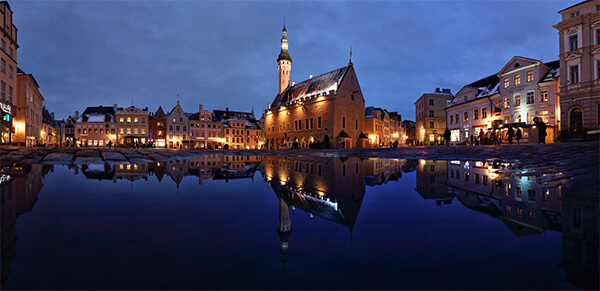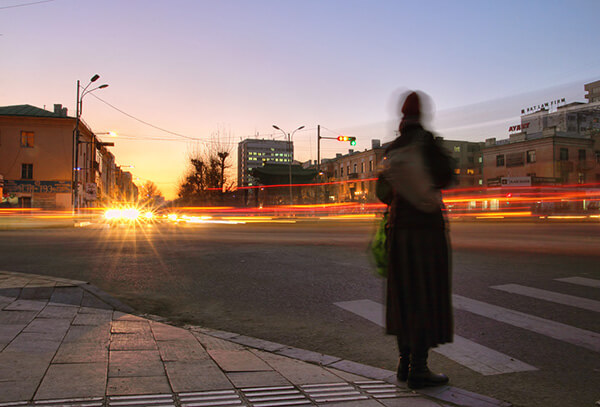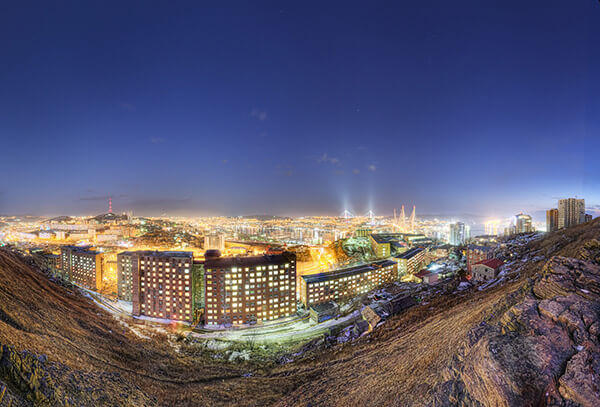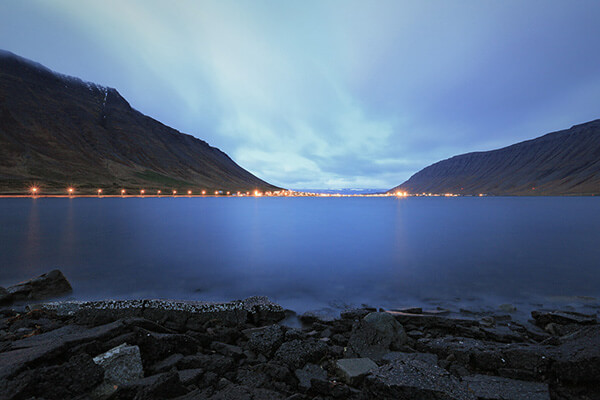Good photographers know that dramatic light means beautiful photographs. That’s why good photographers are always searching, patiently waiting for the best light before they take their pictures. There are many kinds of beautiful light, and one of my favorite times to take pictures is when there’s hardly any light at all.
Introducing Blue Hour
Blue hour refers to the short period of time when the sky is a deep, dark, beautiful blue. It happens twice every day: once before sunrise and once after sunset. The name blue “hour” is misleading as it’s duration depends on where you are on Earth and what season you’re in, and it almost never lasts a full hour. More on that later.
Why Blue Hour Photography Almost Always Looks Good
It allows balanced exposures:
Have you ever tried to take a picture on a bright sunny day, only to have the subject turn out too dark and the sky turn out too bright? Here’s a recent example from St. Petersburg, Russia:
I liked the scene, but it proved difficult to photograph because of the bright sky. You won’t have this problem during blue hour. You also won’t have to deal with shadows, lens flare, and other distracting elements caused by harsh, bright light. Not having to deal with these distractions allows us photographers to focus on what really matters: creating good pictures.
Dim light gives us more creative control:
Bright sunny days necessitate low ISOs and fast shutter speeds. This limits our creativity unless you want to use expensive neutral density filters. The dimly lit, balanced scenes of blue hour allow us a lot of latitude when it comes to setting up our cameras. You can use a high ISO with a fast shutter speed to freeze motion (like I did in the Tallinn panorama at the top of this post). Or you can use a low ISO and slow shutter speed to capture movement like this:
See the starbursts from the car headlights in the photo above? That’s a byproduct of the long exposure and closed aperture (f22). Assuming you like the look, it’s yet another benefit to blue hour photography.
Blue hour is beautiful:
Here’s a recent panorama I shot in Vladivostok, Russia. The city’s yellow lights are emphasized by the dark and beautiful blue sky. You simply can’t get a look like this at any other time of day or night.
Finding Blue Hour
Start here: Gaisma. You can search for your location to find the exact sunrise/sunset times and the estimated duration of dusk. I’m sure they’re using some kind of scientific definition of “dusk”, but you’ll quickly find it’s just an estimate for the purposes of photography. Your camera sees blue in the sky long after our eyes have given up on color and simply accept the sky as being dark.
After I know what time the sunrise/sunset is going to be, I make some educated guesses about how long I’ll have to work.
Your rough guide to blue hour timing:
- Sunset: Blue hour starts getting really good about 15 minutes after sunset.
- Sunrise: Blue hour starts getting good about an hour before sunrise, peaks about 15 minutes later, and quickly gets worse after that.
- It lasts longer during winter and summer months, and it’s shorter during spring/fall
- The farther away from the equator you are, the longer blue hour lasts
- Cloudy weather shortens blue hour
Photographing Blue Hour
You have two main choices: Do you want to capture motion or freeze it? Either way, I find using Aperture Priority mode works best on my DSLR.
Freezing motion.
This technique is useful if you don’t like to carry a tripod around. Set your camera at a high ISO and low aperture. Your shutter speed should settle in the 1/30 to 1/60 range or faster. Using a tripod isn’t necessary, but make sure you’re using image stabilization if you have it.
Capturing motion.
Set your camera at a low ISO and a medium aperture like f/8. Your shutter speed will vary but will likely be one second or more. You’ll need to use a tripod, and you should turn off image stabilization.
Blue Hour in Black and White?
Don’t be afraid to experiment with your blue hour shots if you’re a fan of black and white photography. It seems like a bit of a waste at first, spending all that effort finding the deepest blue sky only to convert your precious color to monotone. But the deep, dark hues of blue hour add a special feel to black and white photos.
Getting Out of the Cities
Getting out of the city means you’ll lose the pretty yellow tungsten color from artificial light that looks so good against a deep blue sky. It therefore suddenly becomes much more important to frame the shot in an interesting way. The exposure also becomes more difficult because the sky will be brighter than the relatively dark landscape.
Here’s a blue hour shot from outside of Ísafjörður, Iceland. The scene is lit only by natural light which gives a deep and dark look to the surrounding landscape. Scenes like this require a bit of experimentation – you’ll probably have to manually increase the shutter speed over what your camera’s meter thinks you should use. The payoff tends to be worth it.
The Most Important Part?
Patience! Far too many photographers are content to shot the sunset, grab a couple post-sunset snapshots, and walk away. The light after sunset gets worse before it gets better, and there is always a blue hour. Generally speaking, the blues get prettier as the sky gets darker, and the last thing you want to do is leave your scene only to find the blues have tremendously improved as you’re walking away. So have fun, be patient, and don’t get so caught up in your pictures that you forget to enjoy actually being there yourself.








Andi Perullo de Ledesma says
LOVE these shots, especially the BA shot!
Ed Graham says
Thank you so much! I’m glad you enjoyed the pictures.
Sue Whitmer says
Very nice blog!
Jennifer Dombrowski says
Thank you very much, Sue! We work hard to make this site a great resource for our readers.
Leigh says
I’ve never heard the term Blue Hour before – magic hour yes – so an interesting read for me. Lovethat first shot in Estonia.
Ed Graham says
Thanks Leigh I’m glad you enjoyed the post 🙂
Cacinda Maloney says
Ed, great post! thanks for sharing Jennifer!
Ed Graham says
Thanks Cacinda!
Fazimoon Samad says
Great post, beautiful shot, good info and advice.
Emanuel says
Thanks for great tips……and sharing some beautiful photos…………
Atul Chauhan says
Those are some great pictures! Blue and golden hour provide most stunning visual to capture. Playing with the composition and shooting with different angle are likely to give a better result than shooting in the default manner.
Thanks